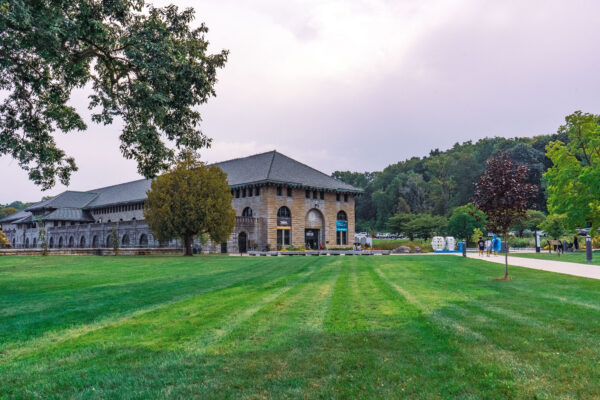Major Power in Canada: The Niagara Falls Power Station
It’s hard to believe that the hulking Niagara Falls Power Station took only four years to construct following the groundbreaking in 1901. An innovative and ambitious project, the Canadian Niagara Power Company began operations in 1905, the first major power producer on the Canadian side of the Niagara River.
New York architect Algernon Bell designed the building to resemble the Niagara Falls Power Company across the river, on the American side. Built in Richardsonian Romanesque style, it has a protective wall with arched windows that surrounds the main building and seemingly rises out of the river, giving the power station a fortress-like appearance.
Constructed with limestone from Queenston near Niagara-on-the-Lake, the building maintains its sense of grandeur on the banks of the Niagara River. Arched windows, from what currently serves as a café and gift shop, provide views on to the Niagara River as it approaches the falls. In the main hallway, transom windows above the doors extend several metres, flooding the generator hall, the area that now houses a museum, with natural light.
While the Canadian Niagara Power Company operated for more than a century, as demand for 25 hertz electricity declined and the cost to upgrade to produce 60 hertz proved costly, operations ceased in 2006. Equipment and materials were left intact in the event the station might one day resume operations. In 2009, it was closed permanently and transferred to Niagara Parks.

In 2017, Niagara Parks engineers undertook an assessment of the building’s structural integrity, leading to a restoration in collaboration with +VG Architects. Construction began the following year to turn the building into an attraction highlighting the city’s lesser-known history as a powerful hydroelectric source with heritage preservation at the core of the redevelopment project.
Today the generator hall, on the main floor, houses artifacts including the governors (the equipment that controlled the turbine speed) and an original elevator used to access the manager’s office. Other artifacts were restored and repurposed, including an original Francis turbine that is now an art piece on display in the gift shop. Throughout the building, resistor banks were repurposed into shelving and benches.
From the main hall, a glass-panelled elevator descends 180 feet, revealing the building’s former inner workings, to reach the restored 2,220-foot long Tailrace Tunnel, where the portal at the end was previously used to expel water into the river in the plant’s heyday. Today, a viewing platform added during the renovations provides slightly drier views of the falls (and the fireworks in summer).

At night, Currents, an interactive sound and light show, in Generator Hall, brings to life stories from former employees of the power station while embracing the structure’s impressive architecture.
Launched in spring 2024, a audio tour further brings the building to life while wandering through the tunnel with tales of when the city was closed to tourism during the Great Wars to protect against any threats or sabotaging the power supply.
Having operated for 101 years, this was the longest operating power plant on the Niagara River. However, it’s not the only power plant in town. Though no longer operational, the Toronto Power Plant by E.J. Lennox will reopen as a five-star hotel following renovations, while a third—the Ontario Power Generating Station—is tucked away beneath Table Rock.




